Analysis of the Linear B tablets and Wall Paintings
Overview
Both
visual and written types of evidence for Mycenaean religion are very difficult
to accurately interpret and comprehend. The written sources, from Linear B, give
archaeologists clear insight into Mycenaean religion but lack detail to reveal
the practices and the aims of the religion. The visual sources, however, show
goddesses, religious practices, events and sacred symbols from Mycenaean times
that were mostly stolen and are heavily-based on Minoan civilization and
language. Around 1450 BC, Minoan Culture experienced a horrible natural tragedy
that many believe to of been an earthquake, and in the wake of mother nature's
destruction the Dynasty of Knossos was overrun by Mycenaean Greeks.
"Prince of Lilies" or "Priest-king Relief" Inside the Palace of Minos, Knossos
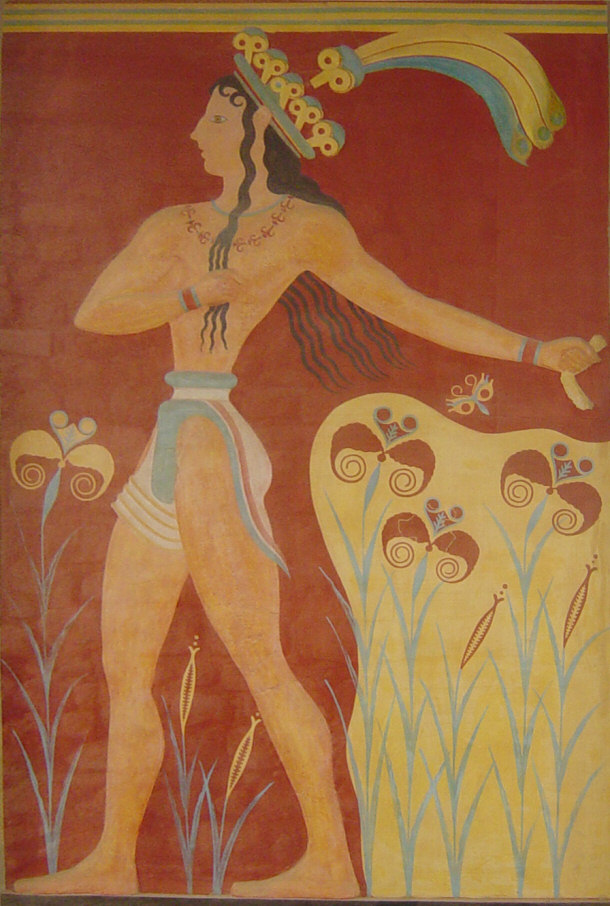
By Photo prise par Harrieta171 (Own work) [GFDL, CC-BY-SA-3.0 or CC-BY-SA-2.5-2.0-1.0],
via Wikimedia Commons
Instead of
destroying the culture that the Mycenaeans now found themselves integrating
with, the Mycenaeans decided to adopt many of facets of Minoan culture and with
a little variation made them their own. This included language, writings, and
architectural as well as artistic disciplines. Linear A is one of the two
currently undeciphered writing systems that were utilized in ancient Crete.
Linear A Inscriptions
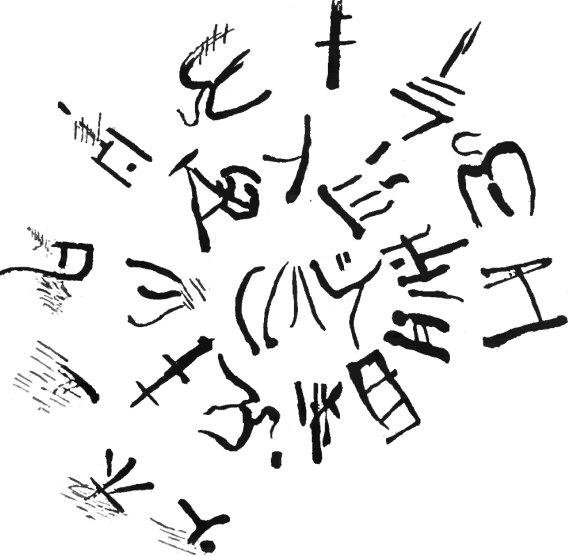
The other are Cretan hieroglyphics. Linear A was the most commonly used
script and it was employed for palace and religious writings of the Minoan
civilization. Linear A is where Linear B originated from, and the Linear B
script would be later used by the Mycenaean civilization.
Linear B tablet from Pylos
.jpg)
By Sharon Mollerus
via Wikimedia Commons
Through written evidence, like the
Linear B tablet from Pylos, and visual evidence such as the Saffron gathering
scene from Akrotiri, archaeologists can produce hypotheses about Mycenaean
religion. This evidence, however, is often very difficult to interpret and
understand, as it only gives small, fragmentary glimpses into their belief
system that is mostly based off of scattered physical evidence as well as
frequent subjective interpretations by translators. Again, the Mycenaean culture
adopted many of the traditions and customs of their captives who were the Minoan
people.
Minoan Clay Tablet found at Knossos Recording Quantities of
Oil Offered to Deities
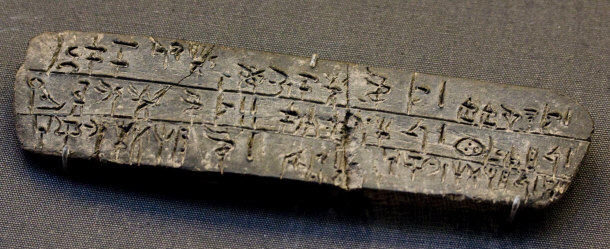
By vintagedept
via Wikimedia Commons
For historians, deciding which things are without a doubt
strongly Mycenaean in nature or instead a conglomerate of Minoan and Mycenaean
attributes, can be extremely difficult even for the planet's experts on early
Greek culture.
Linear B Tablets
 Linear
B tablets do give some evidence concerning Mycenaean religion, however it is
limited in the fact that it only tells us the names of deities, places of
worship, offerings made. These tablets reveal to archaeologists the Mycenaean
religion was in fact different to that of the Minoans and can be linked to the
deities of 8th century Greece, such as Zeus, Hera, Poseidon, Athena, Hermes and
Hephaistos. The term ‘Potnia’, for example, meaning ‘mistress’ (of animals) was
conventionally attributed to the goddess Demeter in Classical Greek mythology is
recognizably used in Linear B tablets. However, although we archaeologists can
decipher the names of the deities, we cannot be certain as to what their
characteristics are, and if they do indeed maintain the same traits as their
Classical Greek counterparts. Information from Linear B tablets is tantalizingly
fragmentary (especially when compared to the Egyptian civilization) and without
literature or written history from this period, very little can be known
directly about the importance of these gods and goddesses. Linear
B tablets do give some evidence concerning Mycenaean religion, however it is
limited in the fact that it only tells us the names of deities, places of
worship, offerings made. These tablets reveal to archaeologists the Mycenaean
religion was in fact different to that of the Minoans and can be linked to the
deities of 8th century Greece, such as Zeus, Hera, Poseidon, Athena, Hermes and
Hephaistos. The term ‘Potnia’, for example, meaning ‘mistress’ (of animals) was
conventionally attributed to the goddess Demeter in Classical Greek mythology is
recognizably used in Linear B tablets. However, although we archaeologists can
decipher the names of the deities, we cannot be certain as to what their
characteristics are, and if they do indeed maintain the same traits as their
Classical Greek counterparts. Information from Linear B tablets is tantalizingly
fragmentary (especially when compared to the Egyptian civilization) and without
literature or written history from this period, very little can be known
directly about the importance of these gods and goddesses.
Mycenaean tablet from Oil Merchant Registering the Amount of Wool to be Dyed
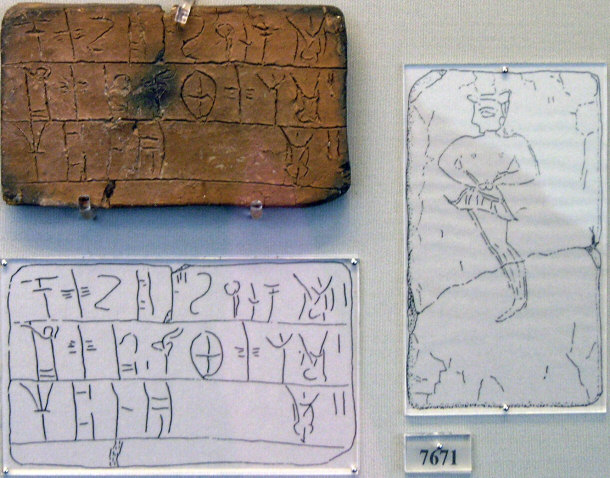
By Sharon Marsyas
via Wikimedia Commons
Linear B tablets also reveal to archaeologists information about offerings
made during religious ceremonies, such as the tablet found Pylos which appears
to list offerings such as pigs, cows, sheep and wild boar to Poseidon’s
religious center and to other deities. It mentions offerings of a man, a woman
and gold vessels which are suggestive of the primitive practice of human
sacrifice, something which is also implicated by the evidence of bodies left in
the doorways of some Mycenaean tombs.
Linear B tablets were also used during Mycenaean civilization that served as an agreement outlining the quantity of wool
that is to be dyed at the House of the Oil Merchant.
Clay Mycenaean Tablets with Linear B Script
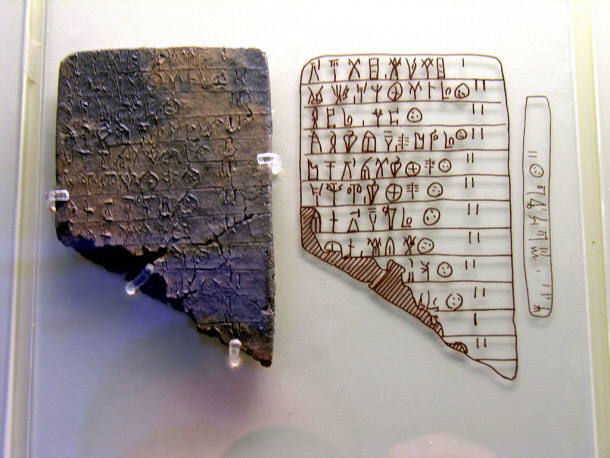
While Linear B tablets are relatively easy
to interpret, there are not many surviving tablets, due to the fragile nature of
the clay and archaeologist only have a few surviving records of religious
practices from these tablets.
Wall Paintings
It is true to say that wall paintings are difficult to accurately decipher.
Archaeologists can only speculate about the significance of each image and what
its meaning may be.
Unknown Minoan Symbols on the Phaistos Disc
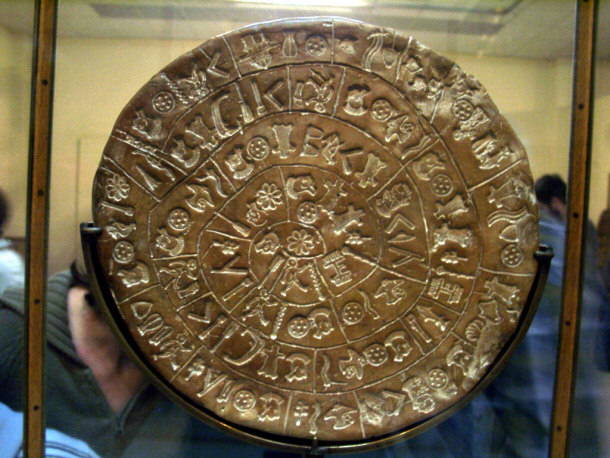
It is only through a “cumulative process of assembling a
variety of evidence” that archaeologists can attempt to suggest the content or
religious significance – if any – of a wall painting.
Minoan Fresco from a Knossos Palace
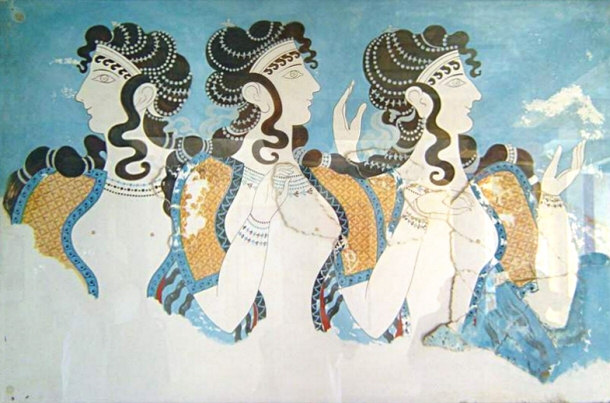
By cavorite
via Wikimedia Commons
It is extremely difficult
to distinguish between Minoan and Mycenaean wall paintings and to gauge whether
these paintings held the same meaning to the Minoans as to the Mycenaeans – for
example, the ‘horns of consecration’, which are depicted in the Room with the
Fresco in the Cult Centre at Mycenae (c. 1250 B.C.), are found at both Mycenaean
and Minoan sites as well as double-headed axes and open air shrines. The
painting behind the altar depicts two extraordinarily tall women, one carrying a
sword and the other, a spear, bow or staff. One of the main centers of the
Minoan civilization is the Bronze Age Palace of Knossos, which is considered to
be the oldest throne room in all of Europe.
Grffin Fresco in the Throne Room of the Palace of Knossos
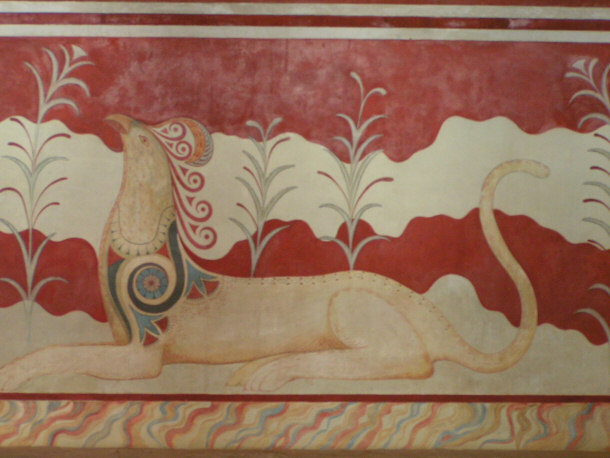
By Paginazero
via Wikimedia Commons
The Palace was beautifully adorned with colorful frescos and
after the Mycenaean occupation of Minoan lands, the Palace remained mostly
intact along with its extremely vivid frescos.
The "Horns of Consecration"
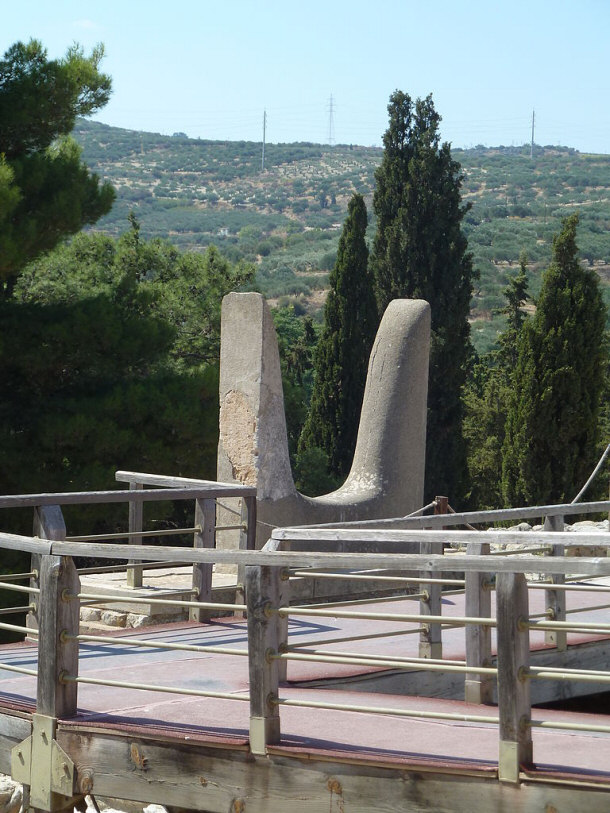
By Deror_avi (Own work) [GFDL or CC-BY-SA-3.0-2.5-2.0-1.0],
via Wikimedia Commons
It is these elements of the fresco
that have led archaeologists to believe that they are female deities, suggesting
a large pantheon of gods and goddesses, that archaeologists still know nothing
about. In the bottom, left corner of the fresco a woman is depicted holding
wheat in both arms, with a lion or griffin beside her, which can be inferred by
the yellow coloring of the animal.
Fresco of Saffron Gatherers from Bronze Age
Excavations in Akrotiri
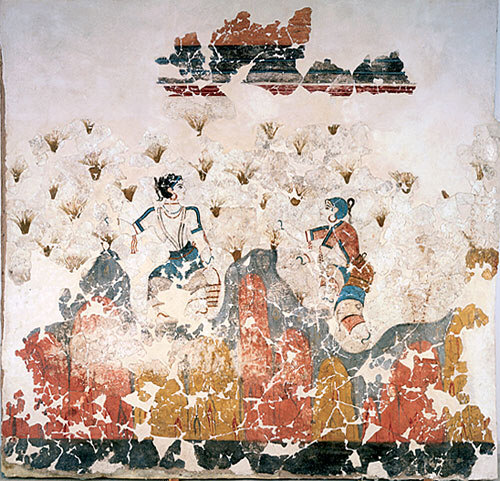
The Saffron gathering scene from Xeste 3 in Akrotiri in Crete (Room 3a, first
floor, N wall, c. 1500 B.C.) is similar in that both possible goddesses have
mythical animal companions (winged griffin, and lion/griffin) and are carrying
plants (like wheat and saffron). There is a richly attired woman seated on a
raised platform.
Clearly her status is exceptional, if not divine, and she has
been named the Mistress of the Animals, which is perhaps a reference to ‘Potnia’,
similar to the findings on the Linear B tablets.
Fresco Entitled "Potnia Theron", "Greek for Mistress of
Animals"
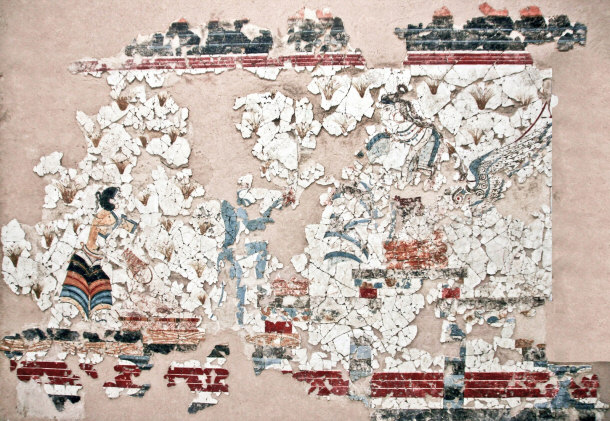
"Master of Animals" or "Potnia Theron" in Greek
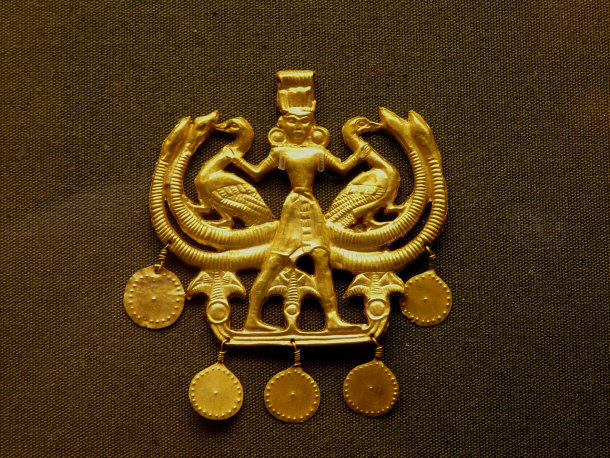
By Bkwillwm (Own work)
via Wikimedia Commons
The blue monkey and the young
girl depicted seem to be deferring to this ‘Mistress of the Animals’, suggesting
some sort of offering or dedication. In this way, we can infer much from the
study of wall paintings, but must remember that any conclusions drawn are not
definite and are still subject to other interpretations.
History
Top Lists:
15 Biggest Architectural Blunders
Top 15 Most Horrifying Terrorist Attacks
15 Fascinating Facts About the Vietnam War
Top 15 Amazing Ancient Egyptian Architecture
20 Little Known Facts About the Titanic
Top 10 Most Creepiest Abandoned Places in the World
26 Interesting Facts About Henry Ford
List of 15 Tough Ancient Warriors Through History
List of 15 Notorious Roman Emperors and Empresses
Top 15 Worst Pandemics in History
15 Things That Remained the Same in the Past 100 Years
Top 15 Things China Invented First
Top 15 Greatest Inventors in History
15 Interesting Facts About Abraham Lincoln
10 Inventors Who Stole Their Ideas
15 Stories of Hilarious Medieval Victories
15 Detectives Credited With Solving The Biggest Cases In History
15 Fascinating Facts About the Ancient Pyramids
15 Inventions That Were the Result of a Mistake
15 Famous Stories of Execution
16 Rare Facts About the U.S. Presidency
15 Astonishing Leadership Stories that Ended up Successfully
Informational:
Analysis of the Linear B tablets and Wall Paintings
Aristophanes and Classical Greek Comedy
The First War of Scottish Independence
|